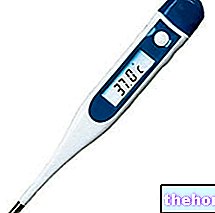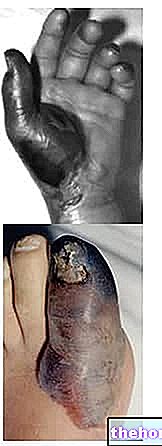Fluid loss from a leg is often a sign of "impaired venous circulation complicated by superficial wounds (venous ulcers). Other times it can be a sign of heart, liver or kidney problems."
During the article we will try to understand why the phenomenon occurs and what are the possible solutions.
To understand: Capillaries, Inflammation, Edema

Exudate
The capillaries only release certain substances to the tissues - such as oxygen, water, glucose, lipids, etc. - present in the blood. In particular, only substances smaller than a certain size are able to cross the capillary wall and reach the tissues; most of the proteins, for example, as well as the blood cells themselves, cannot cross this wall and remain inside the capillaries.
In the presence of a wound, proteins and blood cells (especially white blood cells) need to reach the site of the injury to coordinate the repair processes and ward off any infections. For this reason, in the presence of an inflammatory process (caused by a wound or other factors), capillary permeability increases; consequently, even greater quantities of liquid come out of the capillaries, which accumulate in the lesion forming the so-called exudate. This is why wounds and other local inflammatory processes are often accompanied by swelling of the area, called edema.
The exudate can contain multiple substances, including water, electrolytes, nutrients, inflammatory mediators, leukocytes, proteolytic enzymes (eg. Matrix metalloproteinases - MMP), growth factors and waste materials.
Oozed
Next to the blood capillaries we find the lymphatic capillaries. Their function is to reabsorb the excess of fluid leaked from the blood capillaries, preventing this from accumulating in the tissues.
Under normal conditions, the lymphatic capillaries absorb only small amounts of the fluid leaking from the blood capillaries. About 90% of this liquid is in fact reabsorbed by the blood capillaries themselves.
We must therefore strive to imagine the capillaries as thin tubes, which
- in the initial part (arterial extremity) they release liquid (filtration)
- in the final part (venous end) they reabsorb it (reabsorption).
This mechanism is allowed by the different pressure gradients between capillary blood and interstitial fluids. When these pressures vary from normal, anomalies are recorded in the filtration and reabsorption processes.
In particular, when the pressure at the venous extremity increases, the reabsorption loses effectiveness, excessive quantities of liquids stagnate in the interstitial spaces and the tissue swells.
SKIN INJURIES
In the presence of skin lesions the leakage of edematous fluids is favored and the loss of fluids from the leg can be significant.
Causes
As mentioned in the previous chapter, the loss of fluid in the legs can be caused by:
- wounds and skin ulcers: the associated inflammation causes an accumulation of fluids in the exudate-type area. The presence of these fluids tends to decrease with the healing process; vice versa, if the wound does not heal, due to the persistence of the inflammatory process, the production of exudate may continue and become excessive.
Excessive accumulation of exudate in the wound hinders the healing process. Another important aspect to consider is that the quantities of exudate produced are higher in more superficial and extensive wounds; therefore venous ulcers are more prone to produce high quantities of exudate. to the lower limbs, burns, skin sampling sites and inflammatory ulcers. - poor lymphatic circulation (lymphatic stasis): failure to reabsorb the excess fluid leaked from the capillaries causes an accumulation of fluids in the area; situations of lymphatic stasis occur during some parasitic infestations and neoplasms that compress the large lymphatic trunks, or after their removal during surgery.
- poor venous circulation (venous stasis, venous insufficiency, varicose veins): if the veins are unable to carry adequate amounts of blood to the heart - because you remain on your feet for a long time, because they are less effective due to aging, because you wear clothing tight etc. - the pressure at the level of the venous ends of the capillaries increases; consequently the reabsorption of liquids from the tissues is less effective, edema is created and the leg loses fluids. Among all, this is precisely the most common cause of loss of fluids from the leg.
- kidney problems (kidney failure), liver problems (liver failure) or severe nutritional deficiencies: if there is little protein in the blood (because the kidney lets it slip, because the liver does not produce enough or due to severe dietary deficiencies), the quantities of liquids escaping from the capillaries increase. Consequently, an edema is created which, if of significant size, can drip. Compared to the other causes, edema is generalized in these surroundings, so it tends to appear in both legs and in other areas of the body, such as the abdominal area, which will be edematous with or without dripping.
- heart problems (right heart failure or heart failure): if the right heart fails to empty completely of venous blood, there is an increase in venous pressure; therefore the reabsorption is not very effective and edema occurs. Also in this case the edema is generalized and therefore tends to involve both the lower limbs and also the abdominal organs.
What to do
In the presence of fluid leaks from the leg, the application of an elastic compression bandage is recommended, which must be changed frequently. Application by expert personnel is recommended.
The use of polyurethane foams under the elastic compression bandage is indicated above all in chronic ulcers, since it allows to reduce the frequency of bandages change and to accelerate healing.
Treatment of the underlying causes will need to be planned by a doctor after a "careful diagnosis.




























